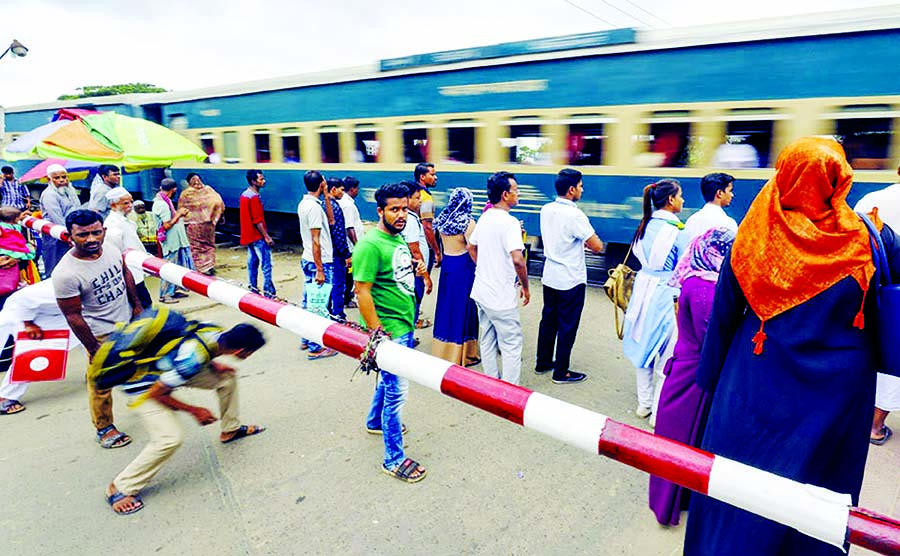
Md Joynal Abedin Khan :
The unproductive level crossings (authorised and unauthorised) are mainly blamed for the rising of rail related fatalities that reportedly cost lives of 209 people in last six months this year.
Experts said, the rail authorities have a tendency to develop infrastructure, ignoring the safety-related issues, which puts rail operations at risk.
If the authorities continue to put emphasis only on structural development without proper safety measures, such fatalities will increase, they fear.
They claimed that the unauthorised crossings are mostly set up by different influential persons without approvals of concerned authorities.
However, the risk posed by unprotected level crossings came to the fore once again after 11 people, including a newlywed couple, lost their lives as a Dhaka-bound train rammed their microbus at an “authorised” but “unmanned” level crossing in Sirajganj’s Ullapara on July 15.
Railways Minister Md Nurul Islam Sujan on Tuesday said that about 2,000 level crossings out of 3,200 across the country are unauthorised. Permission is needed from the Railways to construct roads over rail lines. But many roads are built without approval.
He noted, “The unauthorised crossings lack safety measures. Local Government and the Roads and Highways Department are responsible for the roads.”
“We’re blamed whenever accidents take place at these unauthorised crossings,” he said, adding, “We’ll identify these unauthorised crossings and ensure security there.”
Sujan said that his Ministry will serve notices to the authorities concerned who constructed roads without authorisation of the railways.
Besides, Bangladesh Railway’s latest data prepared in August last year, said that only 466 gates among 1,412 level crossings have gatekeepers. Of the 434 gates in Railway’s east zone, 245 have gatemen and only 221 out of 978 gates in west zone are manned.
Of the 1,085 unauthorised level crossings, 811 are in east zone while 274 are in west zone, the data shows.
At least nine government bodies were involved in constructing illegal level crossings, with the Local Government Engineering Department having built the highest 452.
The acts are blatant violations of the law, which so far remains only on paper, BR officials said.
Transport expert Prof Shamsul Hoque said that different government bodies are constructing unauthorised level crossings, ignoring the railway authorities.
“The government has to stop setting up of such level crossings … The railway authorities have to take steps in this regard,” he said.
Prof Shamsul Hoque, also former Director of ARI, said accident would increase when more double lines and speedy trains start operating.
“But security issues are ignored [in railways plan]. The authorities are more interested in big infrastructure projects … But safety-related projects should get more priority,” he added.
Meanwhile, poor maintenance of level crossings and railway bridges by the authorities, among other issues, contributed to the rise in rail accidents that claimed 209 lives across the country in the last six months, said a report prepared by Shipping and Communication Reporters Forum (SCRF).
The report was prepared based on news published in 22 national dailies, 10 regional newspapers and eight online news portals and news agencies.
Accident Research Institute (ARI) of Bangladesh University of Engineering and Technology (BUET), said that 122 people were killed and 296 others wounded in 103 rail-related incidents till July 15 this year.
Some 244 people lost their lives and 228 others were injured in 235 rail-related fatalities in 2018, while 229 died and 156 were hurt in 211 such incidents the previous year, said the ARI.
Most of the incidents happened when trains ran over people or rammed vehicles at unprotected level crossings and nearby rail lines, said Imran Uddin, a lecturer at the ARI.

